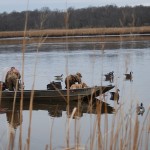DNR Announces 2015-2016 Late Waterfowl Seasons
The Maryland Department of Natural Resources announced today the 2015-2016 late waterfowl seasons.
Highlights include:
- Youth waterfowl hunting days on November 7, 2015 and February 6, 2016
- Regular duck hunting season segments on October 10-17, November 14-27 and December 15-January 30, with a daily bag limit of six ducks, including two canvasbacks
- Migratory Atlantic Population Canada goose hunting segments on November 21-27 and December 15-February 3, with a daily bag limit of two geese
- Late resident Canada goose hunting segments on November 21-27 and December 15-March 9, with a daily bag limit of five. The Canada goose hunting zone map (i.e. migrant and resident) and the Migratory Game Bird Hunting Seasons flyer are available online.
“We conducted an extensive public outreach effort, including an online forum and public meeting, to collect comments on the proposed hunting seasons. We also consulted closely with members of the Wildlife Advisory Commission and Migratory Game Bird Advisory Committee,” said DNR Waterfowl Project Leader, Larry Hindman.
All migratory game bird hunters, including landowners who are license-exempt, must purchase the Maryland Migratory Game Bird Stamp/HIP Permit. All waterfowl hunters 16 years of age or older must also possess the Federal Migratory Bird Hunting and Conservation Stamp (federal duck stamp), which must be signed in ink across the face. Hunters buying the federal stamp online may use the purchase code or printed receipt to show proof of purchase for 45 days. Hunters will receive their stamp in the mail from the U.S. Fish and Wildlife Service within this time frame.
Licenses, stamps and permits may be purchased online via COMPASS, by phone at 1-855-855-3906, at a DNR Service Center or at any one of the more than 250 Sport License Agents across the State. For more information, visit dnr.maryland.gov/service.
DNR reminds waterfowl hunters that boating safety becomes even more critical during the fall and winter months as daylight decreases, water temperatures drop, and fewer people are on the water to assist in the event of an emergency.

 1-888-373-7888
1-888-373-7888 233733
233733